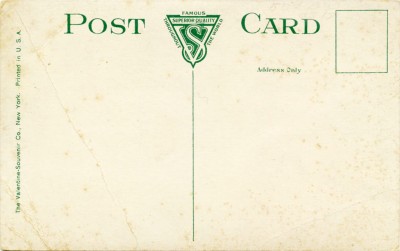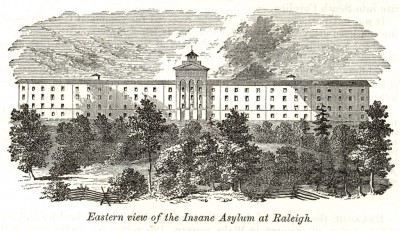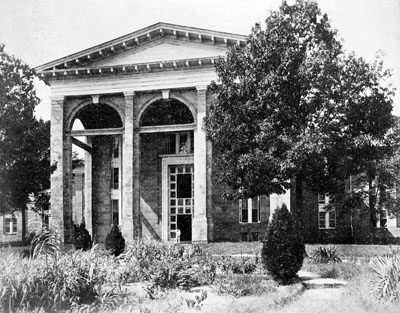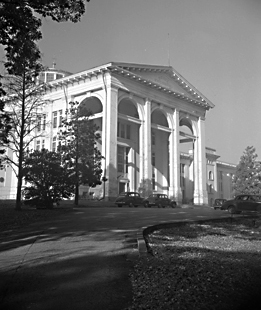State Hospital, Raleigh, N.C.
Our Flashback Friday postcard this week features an early view of Raleigh’s Dorothea Dix Hospital. Once known as the state ‘lunatic’ or ‘insane’ asylum, Dix Hospital cared for North Carolina’s mentally ill for more than 150 years.
No message on this week’s card.
Long known as the ‘State Hospital’, or simply ‘Dix Hill’, the facility was renamed Dorothea Dix Hospital in 1956 by the state legislature in honor of Dorothea Dix (1802-1887), a prominent 19th century advocate of humane treatment of what were then referred to as the insane. In 1848 she had lobbied North Carolina legislators to create a state institution where the mentally ill could receive proper care.
Dorothea Dix, passionate advocate for the mentally ill.
As a result of her influence, a legislative commission was created to establish and locate a suitable site for a state-supported institution to treat the mentally ill.
In 1851 the commission declared
“. . . after carefully examining the whole country in the vicinity of Raleigh, we chose a location west of the city and about one mile distant, which in our opinion was best adapted to that purpose . . . This location has a commanding view of the city and is believed to be perfectly healthy. The grounds are beautifully undulating and susceptible of improvement.â€
The state hired the nationally renowned architect Alexander Jackson Davis, a principal in the New York-based firm of Town and Davis, to design a modern facility to accommodate the new hospital.
The first patient was admitted February 22, 1856.
This illustration of the new state ‘insane asylum’ (above) depicts the facility as it appeared ca 1860. Below is artist CN Drie’s rendition as is seen in his famous 1872 ‘Bird’s Eye View’ of Raleigh.
Below is a ca 1900 photo view of the central pavilion of Dix Hospital. It featured a dramatic entrance and skylight-topped rotunda. The pavilion was demolished in the early 1950s, and replaced by the modernist-styled McBride administration building.
Here is another view of architect Davis’ central pavilion, as it appeared in the 1940s. It is very similar to the view seen in this week’s postcard.
Here we see a broad view of the central pavilion and the east wing of the hospital. All of the architectural embellishments of Davis’ original design were removed in the 1950s.
The Spring Hill Connection
Colonel Theophilus Hunter established Spring Hill plantation in the 179os, and is buried adjacent to his former homeplace. His son, Colonel Theophilus Hunter, Jr. inherited the property in 1798 and erected Spring Hill house in 1816. When he died 1840 the plantation comprised 5,000 acres. The state of North Carolina purchased 182 acres from his estate in 1851, which became the core of the Dix Hill property. William Grimes bought Spring Hill in 1872, and upon his death in 1908, his widow sold Spring Hill house and an additional 160 acres to the state, thereby enlarging the grounds of Dix Hospital.
Dix Hill Central Park
The Dix Hill Historic District, which includes Davis’ original hospital building and Spring Hill house, was designated a Raleigh historic site in 1978, and was listed on the National Register of Historic Places in 1990.
Ten years ago the state moved to close Dix Hospital, and to relocate patients to a repurposed Umstead Hospital in Butner, NC. Soon thereafter, a popular campaign emerged, which proposed to transform the Dix property into a destination ‘central park’ to be based in Raleigh for the enjoyment of all North Carolinians. In the forefront of this effort were two grass-root organizations: the Friends of Dorothea Dix Park and Dix 306. And, happily, their efforts have prevailed, as the Council of State and the City of Raleigh have just this month reached an agreement to establish a park on the Dix Hill property.
This week’s beautifully-tinted Flashback Friday postcard was published by the Valentine-Souvenir company of New York City.
Valentine-Souvenir (1914-1923)
New York, NYFormed by the merger of the Leighton & Valentine Company with the Souvenir Post Card Company. They published tinted halftone view-cards in line block that were printed in the United States.
While their later white border cards retained the usual limited pallet, these cards have an entirely different look. There is much more emphasis on the details that are printed in black rather than the color overprinting.
“Flashback Friday†is a weekly feature of Goodnight, Raleigh! in which we showcase vintage postcards depicting our historic capital city. We hope you enjoy this week end treat!










 Sign up for the Newsletter
Sign up for the Newsletter
12/21/2012
Thank you so much, Karl, for this wonderful history and these beautiful pictures. Wouldn’t it be great to see this building restored to its original splendor?! Your readers may not know that A. J. Davis also designed the N.C. State Capitol, and Lyndhurst, one of the most beautiful castles in the world.
12/21/2012
I was just over on the property the week looking at Spring Hill. I found the Dix Hospital cemetery. Does the A. J. Davis building still stand? It looks like the main building is
a horrible orange 1970’s building.
01/04/2013
John, the large central pavilion was demolished in the 1950’s. Those present at the time say that it was in pretty bad condition, and for the last few years it was standing it was unused by patients and staff. The east and west wings of the original building are still there. They are pretty easy to pick out if you go to the property.
01/04/2013
The west wing, and maybe part of the women’s pavilion at the end of the west wing, were badly damaged by fire in 1926, but the damage was repaired and the building restored as it was.
01/07/2013
Is there anything of the Spring Hill House still standing? Despite growing up in west Raleigh (the area I knew as Fairmount) we were not allowed over on Dix Hill, and I did not know anything about Spring Hill plantation. Great information!! I hope that in some way the city can memorialize Ms. Dix, as her work for the humane treat of the insane was very important.
01/07/2013
pBeez: follow the link in the article. The house still stands and is now owned by NC State University.
01/24/2013
These images were very helpful for me and bettered my understanding of the concept(s) each picture above represents. I am currently doing a project on Dorothea Dix and the Asylum Movement. One of the images above was incorporated into my final project with proper credit given. Very beneficial images
01/25/2013
Vanessa: Glad you found this post helpful to your Dix project. If you need a hi res version of the image please contact me via the ‘contact’ link on the homepage.
02/04/2014
After researching Dorthea Dix for quite some time, your article put events in a more friendly user functional. What I would really like to know is are there more than one cemetery for the patients that were cared for by the hospital? I have a connection with a patient from my families past and I have always wanted to vistit the cemetery and to give a proper prayer. Is there any way you can help direct me to the people I would need to speak with?
02/05/2014
Deanna: Thank you for the kind words — glad you enjoyed the article! There was only the one 3-acre cemetery for patients on the grounds. (The much smaller Theophilus Hunter family cemetery still exists behind Spring Hill House, however.)
Here is a link to a very informative online history of the Dix Hill Cemetery: http://cemeterycensus.com/nc/wake/cem244.htm It includes a listing of more than 750 of the 900+ people buried in the cemetery. Perhaps you will find your relative there.
05/15/2014
My Great Grandfather, Benajah Dixon,(mispelled as Dickson in most census and also in the Superior Court of Duplin County papers when he was declared a lunatic in 1877 and sent the Lunatic Hospital of NC} I have a copy of the Affirmation of faith to the army of the Ohio that he signed in Raleigh on May 24 1865, to be let go as a POW. Born abt. 1836, sent to Lunitic Hospital in 1877 but was listed on the 1880 census at his house in Duplin County with his wife also listed as insane on this census. I am thinking that in 1880 his wife just listed him at their house even though he was probably still inthe Lunatic Hoapital in Raleigh at that time. Are there any records on him at the hospital back then? I do not what happeded to him, where he died, where he is buried, his father or mother’s name or whish unit he served in in the Civil War or his rank. Where can I find the 1880 census that shows those persons in the Lunatic Hospital at that tine? If there are records on him where are they and can I red them on the Internet. I can’t go back any further on our family tree until I gain some of this information. I have copies of the origionals for: The affirmation of Faith, Inventory card listing him as a POW, 1877 Lunitic Records for Duplin County with his name listed. and 6 pages of the court documents when he was declared a lunatic and sent to Lunitac Hospital of NC. I am thanking you in advance for any help and directions you can peovide to me.
05/17/2014
Forrest Cheek,
Contact me at benajah.dixon(at)gmail.com — I may be able to help you.
06/17/2014
My great uncle Christopher Theofield was an inmate at this hospital from about April 1933 till his death July 18, 1936. The last living relative that remembers my great uncle indicated that he was sent here as a retribution for his support of desegregation. His crime, as told to me, was indecent exposure. His supposed victims, wives and female relatives of members of the Klu Klux Klan. Can anyone point me to sources that would help me find information about my uncle and what happened to him such as what crime he was convicted of, when where and by whom he was sentenced, and any additional information about a trial or appeal?
thanks
02/22/2015
My 3 x Great Aunt was a patient at the Hospital doing the time frame between 1862-1870 she died there 10 June 1870 and was buried at the City Cemetery in Raleigh, NC. I would like to know if there are any records pertaining to her and how would I go about in retaining a copy of them for my genealogy research.
03/03/2015
I am looking for info on a Georgia Ida Ward Watson who was my great grandmother an was an inmate for 16 yrs until she died in 1916 at 38 yrs of age. Anything would help. Thank You
03/03/2015
Per her death certificate a Georgia Ida Watson residing at the State Hospital in Raleigh died 26 May 1916. Her father’s name is given as “Ward”, her mother as “unknown”. She was born in Columbus Co, and buried in Whiteville at the Lebanon United Methodist Church in the community of Williams in Columbus Co.. The cause of death was tuberculosis. She resided in the hospital four years, two months and 16 days. She was born in 1878, the child of Pinkney Ward and Frances White. Married Guston Vance Watson in February 1898 in Columbus Co, NC. He died in 1962 in Wilmington. They seem to have lived their lives (1900 & 1910 censuses) together in Columbus Co.
03/13/2015
Mary Ann Butts was my 3 x Great Aunt she was a patient at the State Hospital doing the time frame between 1862-1870 she died there 10 June 1870 and was buried at the City Cemetery in Raleigh, NC. I would like to know if there are any records pertaining to her and how would I go about in retaining a copy of them for my genealogy research.
Thanks.
03/14/2015
How does one go about finding records of those who were residents here in the 1900 to 1940’s
thanks
07/11/2015
In researching my Young family ancestry, I found in the
1950 US Census High Point, Guilford County that my Grandfathers sister was remanded to the State Hospital.
Any information you can sent me will be appreciated
Fannie V. Young Peebles
b. 19 Aug 1893 Stokes County NC d. 28 July 1976 High Point
husband: William D. Peebles
address: 214 Shelton Street High Point, NC
Thank you very much,
Deborah Y. Thomas
01/30/2016
i have found a sambo edwards, the son of samuel and daisy edwards, who was born in 1914 in hertford county,nc and buried there too. his death certificate states that he died in raleigh at doreatha dix hospital in july of 1944.
can any information be found for my genealogy records?
03/16/2016
In the mid-sixties I ws taken from Central Prison in Raleigh to the Spruill Building for the Criminally Insane at Dorothea Dix State Hispital and was forcibly given a series of twelve ECTs [electro-convulsive treatments] (three a week for four weeks). This was nothing but experimental torture.
08/23/2016
What happened to patient records from the early 1900’s? Where are they located now? Thanks for any help.
07/22/2019
My Dad was an NC State educated architect in Raleigh. He designed and built our family home from old brick sourced from the ‘old’ Dix Hill Hospital that was torn down in the 1950’s. I have a receipt for the brick!
During the cleaning of those brick ( we brushed them with wire brushes for days and days ) we found 100+ bricks that had names carved / written into their surfaces. Surnames as best I know. I own 2 of these.
Would love to know more about the original building and its construction – pre Civil War I assume.
07/24/2019
Marsha,
Would you have access to your father’s old drawings?
I may live in one of his houses now. That is the speculation of NC Modernist Houses site, anyway.
FYI, I’m an NC State educated architect also.
05/22/2020
My mother, Minnie Belle Topping was there sometime in the year 1940 to around 1950. I was in an orphanage at the time and would appreciate any information you can give me. She had shock treatments which knocked out her teeth.
09/21/2020
I was very interested in the photos. I am researching a person who was admitted in 1867 and died there 1878, all I have is that she was in for long term “uterine disease.” I don’t suppose there is much to the cemetery as far as markers?
12/17/2020
Any information on an ancestor that died there in 1940. J.B (Bay)Roberson .Murdered his family.